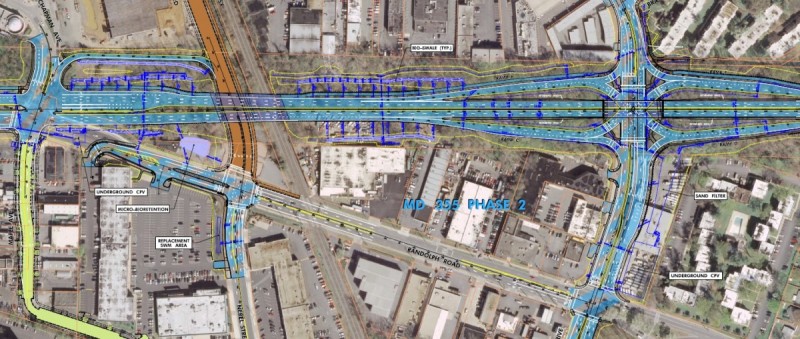Montgomery County must improve pedestrian safety in White Flint, advocates say

Image by Caitlin Faw used with permission.
In early November, a Silver Spring pedestrian was killed in what Montgomery Police tentatively are calling a hit and run. A few days before that, another pedestrian was struck and killed by a motorist while crossing the street in Takoma Park. And in late October, a third pedestrian was struck while crossing the street in Gaithersburg. That’s three tragic pedestrian fatalities in less than a month in our area.
While we do not want to speculate on the circumstances of these incidents while all three remain under investigation, these tragedies nonetheless should serve as an important reminder that pedestrian safety on Montgomery County’s busiest roadways remains a pressing public safety issue.
In response to these public safety concerns, MoCo is one of the first counties in the country to adopt the Vision Zero concept, an ambitious goal of eliminating all pedestrian deaths by 2030. But is the county doing all that it can? Are we aligning our resources and public safety improvement projects in a way which most efficiently and effectively protect our pedestrians?
The answer for some community advocates is a resounding NO.
Location of the 10/21/17 fatal pedestrian accident in Gaithersburg. Image by the author.
Despite the County’s Vision Zero initiative and programs, residents in many neighborhoods like Forest Glen and sections of White Flint still must gamble with their lives as they try to access transit and other amenities in the county.
Fortunately, now we have an opportunity to do something about it.
Retrofitting people into a car world
Montgomery County has a history of successfully creating walkable communities. Today, downtown Silver Spring and Bethesda consist of a vibrant mix of housing, retail and transit which allow for an urban experience that can rival many urban parts of cosmopolitan DC.
Yet other MoCo neighborhoods near transit haven’t seen the same level of investment in safe and walkable neighborhoods, even though these kind of investments would allow for better access to amenities and could promote future economic growth. To make matters worse, projects like the Montrose Parkway East have threatened the new urban nature of neighborhoods like White Flint, which are currently experiencing a kind of renaissance since the completion of the new Pike and Rose development.
Montrose Parkway East Project Limits. Image by MCDOT used with permission.
More cars in Rock Creek?
According to Dan Reed, GGWash contributor, urban planner, realtor, and author of the blog Just Up the Pike, transportation planning for the current version of Montrose Parkway began in 1998 and resulted in the construction of the segment west of Rockville Pike, which opened in 2010.
The State Highway Administration (SHA) and the Montgomery County Department of Transportation (MCDOT) insist that the controversial Montrose Parkway East is needed to handle anticipated traffic from the redevelopment of White Flint. Reed suggests that recent studies and local examples prove that compact, mixed-use development like White Flint will actually reduce traffic, raising the question whether MCDOT and SHA’s concerns are actually valid.
So why are we looking at adding more cars to the road and destroying our county’s already limited green space? The proposed Montrose Parkway East not only disrupts the urban flow of White Flint but it literally tears through Rock Creek Park. Below marked in red is the proposed pathway for the parkway.
As it stands, the “Parkway” is set to destroy hundreds of mature trees that currently act as a buffer for many homes and parks.
Image by Montgomery Parks used with permission.
The Winding Creek Local Park will be affected the most by having a pretzel-like interchange right around the corner from what many consider a green urban oasis.
Image by MD – State Highway Administration used with permission.
White Flint’s urban problem
Many have expressed concern that the proposed Montrose Parkway East would also become a barrier between White Flint and Twinbrook, making it very difficult for people to walk or bike from one side of this area to the other.
In the past, former MoCo Planner Larry Cole argued that the large size of the planned Montrose Parkway was simply due to land availability. To Cole, it seemed that the county and state’s plans were “overdesigned” and overestimated the amount of future car traffic in White Flint.
So what would happen if the $140 million dollars committed to the Parkway were used for other purposes? Some would like to see it used to increase pedestrian safety in White Flint. Others would like to see it go towards the construction of two new metro entrances in White Flint and Silver Spring. It could also pay for new bike programs and redesign of one of MoCo’s most blighted thoroughfares, Georgia Avenue.
Coming tomorrow: Part 2 — The Forest Glen quandary. This post was first published on Finding Forest Glen.

